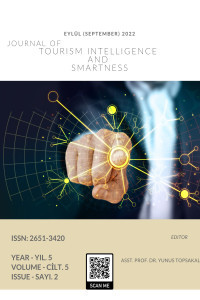A Study to Develop Scale for Determining the Social Innovation Perspectives of Entrepreneurs
Social Innovation, Entrepreneur, Social Innovation Scale, Tourism
A Study to Develop Scale for Determining the Social Innovation Perspectives of Entrepreneurs
Social Innovation, Entrepreneur, Social Innovation Scale, Tourism,
___
- Bozdoğan, A.E. & Öztürk, Ç. (2008). Improving of Self – Efficacy Scale of Geographic Conceptions Embedded Within ‘Science’ Course: A Case for Prospective Science Teachers. Necatibey Faculty of Education Electronic Journal of Science and Mathematics Education, 2(2), 66-81.
- Büyüköztürk, Ş. (2002). Factor Analysis: Basic Concepts and Using to Development Scale. Educational Administration in Theory and Practice, 32, 470-483.
- Büyüköztürk, Ş. (2003). Handbook of Data Analysis, Ankara: Pegem Publications.
- Büyüköztürk, Ş. (2012). Handbook of Data Analysis for Social Sciences, Ankara: Pegem Publications.
- Choi, N. & Majumdar, S. (2015). Social Innovation: Towards a Conceptualization. In M. Satyajit, G. Samapti, M. Nadiya (ed.), Technology and Innovation for Social Change. India: Springer, 7-33.
- Dhondt S., Oeij, P., Totterdill, P., Howaldt, J., Hootegem, G. & Gramberen, M. (2012). Workplace Innovation as Social Innovation. The Dortmund Brussels Position Paper on Workplace Innovation, 26-27 April 2012, Dortmund/Brussels, 1-11.
- Eatwell, J., Milgate, M. & Newman, P. (1989). The New Palgrave: Economic Development, Basingstoke: MacMillan.
- Erkorkmaz, Ü., Etikan, İ., Demir, O., Özdamar, K. & Sanisoğlu, S.Y. (2013). Confirmatory Factor Analysis and Fit Indices: Review. Journal of Medical Science, 33(1), 210-223.
- Groot A. & Dankbaar, B. (2014). Does Social Innovation Require Social Entrepreneurship?. Technology Innovation Management Review, 4(December), 17-26.
- Howaldt, J. & Schwarz, M. (2010). Social Innovation: Concepts, Research Fields and International Trends. Dortmund, Sozialforschungsstelle.
- Kalleberg, A.L. (2011). Good Jobs, Bad Jobs: The Rise of Polarized Employment Systems in the United States, 1970s-2000s. Distinguished Lecture Series, Department of Sociology, University of North Carolina at Charlotte.
- Köymen, U. (1994). The Learning and Study Strategies Inventory: Reliability and Validity Studies. Turkish Psychological Counseling and Guidance Journal, 2(1), 19-28.
- Likert, R. (1932). A Technique for the Measurement of Attitudes. In R.S. Woodworth (ed.), Archives of Psychology, New York: New York University.
- Mulgan, G. (2007), Social Innovation: What It Is, Why It Matters and How It Can Be Accelerated. Oxford: Oxford Said Business School.
- Murray, R., Mulgan, G. & Caulier-Grice, J. (2009) How to Innovate: The Tools For Social Innovation. London: NESTA and Young Foundation.
- Neumeier, S. (2012). Why Do Social Innovations in Rural Development Matter and Should They Be Considered More Seriously in Rural Development Research? – Proposal for A Stronger Focus on Social Innovations in Rural Development Research. Sociologia Ruralis, 52(1), 48-69.
- Nunnally, J.C. (1970). Introduction to Psychological Measurement, New York: McGraw-Hill Book Company.
- OECD (2005). Environmental Policy, Technological Innovation and Patent Activity: Initial Empirical Results and Project Progress, Report of the Working Party on National Environmental Policy. Paris: OECD Publishing.
- OECD (2012). Innovating for Global and Societal Challenges, Paris: OECD Publishing.
- Oltra, V. (2008). Environmental Innovation and Industrial Dynamics: The Contribution of Evolutionary Economics, 1st DIME Scientific Conference, 7-9 April 2008, BETA, University Louis Pasteur, France.
- Otrar, M. & Argın, F.S. (2015). A Scale Development Study to Determine the Attitude of Students’ Towards Social Media. Journal of Research in Education and Teaching, 4(1), 391-403.
- Pol, E. & Ville, S. (2009). Social Innovation: Buzz Word or Enduring Term?. Journal of Socio-Economics, 38(6), 878-885.
- Prevent, L.E., Dhondt, S., Oeij, P., Pot, F., Nicolescu, G.I. & JWebster, J. (2012). Review of Workplace Innovation and Its Relation with Occupational Safety and Health. Luxembourg: Publications Office of the European Union.
- Rogers, E.M. (2003). Diffusion of Innovations. New York: The Free Press.
- Schienstock, G. & Hamalainen, T. (2001). Transformation of the Finnish Innovation System: A Network Approach, Helsinki: SITRA.
- Schumpeter, J. (1934). The Theory of Economic Development: An Inquiry into Profits, Capital, Credit, Interest, and the Business Cycle. Cambridge: Harvard University Press.
- Şeker, H., Deniz, S. & Görgen, İ. (2004). Teacher Competency Scale. Journal of National Education, 164, 105-118.
- Seyfang, G. & Smith, A. (2007). Grassroots Innovations for Sustainable Development: Towards A New Research and Policy Agenda. Environmental Politics, 16(4), 584-603.
- Tabachnick, B.G. & Fidell, L.S. (1996). Using Multivariate Statistics. New York: Harper Collins College Publishers.
- Tavşancıl, E. (2010). Measurement of Attitudes and Data Analysis with SPSS. Ankara: Nobel Publications.
- Tekin, H. (1993). Assessment and Evaluation in Education. Ankara: Yargı.
- Tezbaşaran, A.A. (1996). Likert-Type Scale Development Manual. Ankara: TPD Publications.
- Tezbaşaran, A.A. (1997). Likert-Type Scale Development Manual (2nd edition). Ankara: TPD Publications.
- Tuomi, M. (2012). Diffusion of Social Innovations across the Borders Social Sector Cooperation with the Republic of Kareli. Publications of the University of Eastern Finland, dissertations in Social Sciences and Business Studies, No.33, Finland.
- Varım, S. (2001). Technology, Innovation and Knowledge Economy. Ege Academic Review, 1(1), 192-201.
- Ventura, K. (2017). AMOS (Analysis of Moment Structures) ve Yapısal Eşitlik Modeli, http://web.deu.edu.tr/upk15/docs/seminerSunumlari/AMOS%20(ANALYSIS%20OF%20MOMENT%20STRUCTURES)%20VE%20YAPISAL%20ESITLIK%20MODELI-YRD.%20DOC.%20DR.%20KETI%20VENTURA.pdf Accessed: 27.02.2019
- Westley, F. & Antadze, N. (2010). Making A Difference: Strategies For Scaling Social Innovation For Greater Impact. Innovation Journal, 15(2), 1-19.
- Zeller, R.A. & Carmines, E.G. (1978). Statistical Analysis of Social Data. Chicago: Rand McNally College Publishing Company.
- Başlangıç: 2018
- Yayıncı: Yunus TOPSAKAL
Yerli Turistlerin Tatil Satın Almadan Önce Tercihlerine Etkisi Olan Faktörlerin Belirlenmesi
Yönetim Muhasebesi Uygulamalarının İncelenmesi: Erzurum İli Otel İşletmelerine Yönelik Bir Araştırma
Nilgün SANALAN BİLİCİ, Barış TURAN
A Study to Develop Scale for Determining the Social Innovation Perspectives of Entrepreneurs
Yunus TOPSAKAL, Nedim YÜZBAŞIOĞLU
